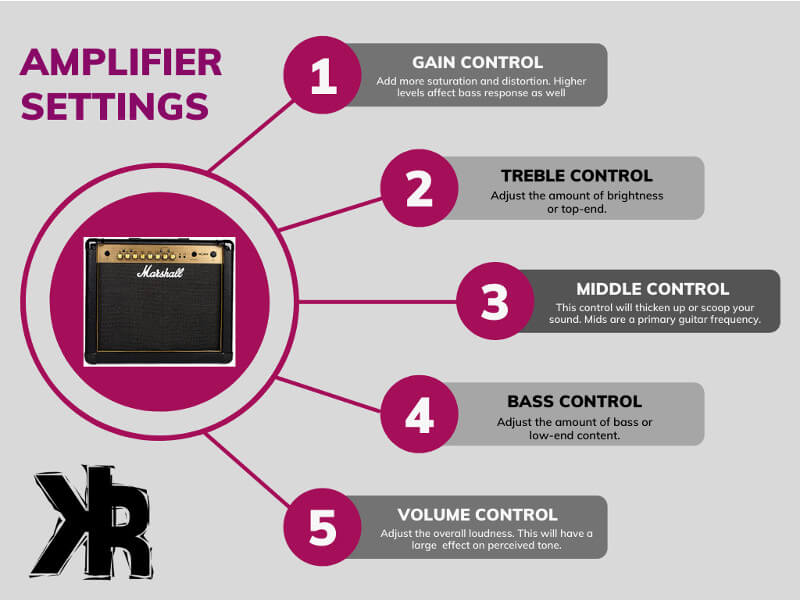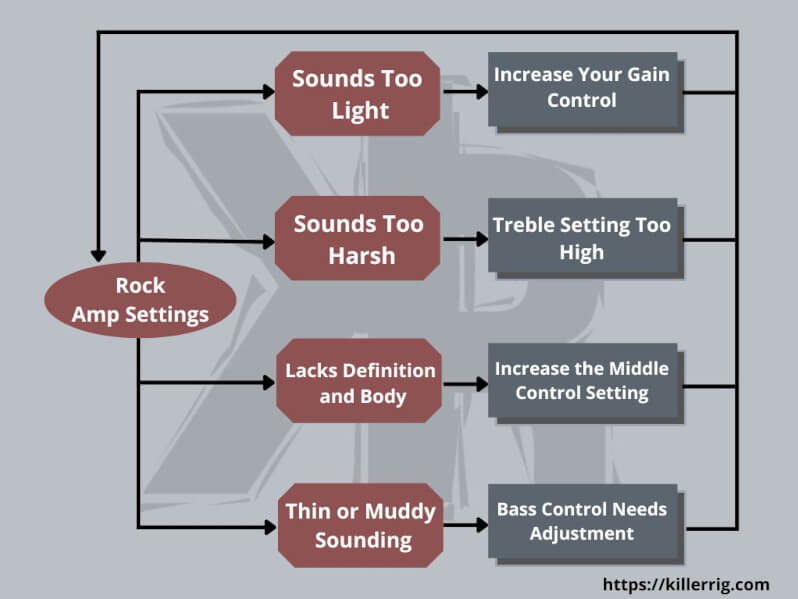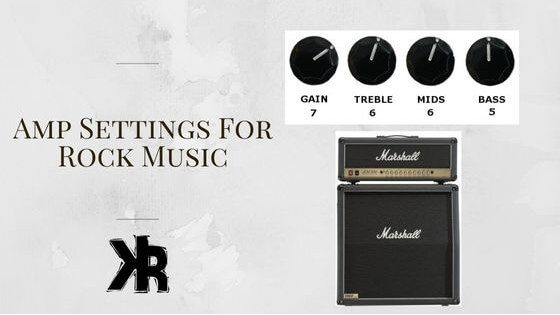Table of Contents
Rock music has been around for many decades! It’s loved by people from around the world. The one instrument that defines it more than any others is the guitar. But how do you make it sound like rock, and what amp settings work best?
This is a difficult question to answer, as most amps sound completely different when set the same. That’s why it’s important to experiment with your sound. Try different settings until you find something that works for you.
Quick rock guitar amp settings are:
- Gain: 5-7.
- Treble: 5.
- Mids: 6.
- Bass: 6.
In this Killer Rig guide, we will look at what the amp settings do and how to use them to get a great rock tone. We will also explore some popular rock songs and the settings used to obtain their sounds.
What is a Rock Tone?
Rock tone is a bit of an elusive term. It can mean different things to many people. In general, rock tone is defined by its aggressive sound and heavy distortion. This is why gain and treble are usually set fairly high on most rock amps.
Mids are also an important part of the rock sound, as they help to add definition and clarity to the guitar’s tone. Bass is typically set lower, as it can often muddy up the sound when too high.
Of course, these are just general guidelines and there are no hard and fast rules when it comes to setting your amp. Experimentation is key in finding the right sound for you.
How to Use Your Amp Settings
As we mentioned before, gain, treble, mids, and bass all play a role in shaping your sound. Let’s take a more in-depth look at how each of these settings affects your tone.

Gain
The gain control on your amp determines how much distortion you get. Turning the gain up will give you a more distorted tone. Lowering it will give you a cleaner sound. For most rock tones, you don’t want the gain up too high.
Treble
The treble control determines how bright or dark your sound is. Turning the treble up will make your sound brighter. Conversely, setting it low will make it darker. For rock, you will usually want the treble set fairly high as well, just not piercing.
Some players even prefer a darker sound, so experiment to find your favorite setting.
Mids
This control sets the amount of mid-range frequencies which are present in your sound. A higher mids setting will fill out the tone, while a lower one will give you a scooped sound.
For rock, you will want to experiment with different mid-range settings. You want to find what works best for you. Generally, the perfect amount will add character to the crunchiness of the sound. This is a setting of 5 or higher in most cases.
Bass
The bass controls the low end of your tone. For rock, you will usually want the bass lower, as it can muddy the sound when set too high. Your gain control will also affect your bass content, so this is often best to set last.
For a more in depth look, check out our guide on settings and controls.
Popular Rock Songs and Their Amp Settings
Now you know how the amp controls work. Let’s take a look at some popular rock songs and the settings used to obtain their sounds.
Come Together – The Beatles
Come together is a popular rock song by the Beatles that is distorted, but probably not by an amp. It is said that they drove their tube mixing board into distortion to get that sound.
The amps they played were more than likely Fender Twins, set clean, clear, and loud. Today, it is also possible to get this tone with a Vox AC30 or similar sounding amplifier.
Good settings on the Vox AC30 to get this rock sound would be:
- Gain: 6.
- Treble: 8.
- Mids: 9.
- Bass: 5.
Satisfaction – The Rolling Stones
Satisfaction is a classic rock song by the Rolling Stones. It is one of the first songs to make use of heavy guitar distortion. The sound was achieved by using a fuzz pedal, which was turned quite high and then used with a tube amp.
The amp used by Keith Richards was a Fender Dual Showman. It was turned up fairly loud, giving it great clarity and a tube feel.
Settings on a Fender amp to get this rock sound would be:
- Gain: 5.
- Treble: 7.
- Mids: 6.
- Bass: 5.
Welcome to the Jungle – Guns N’ Roses
Slash’s guitar tone was iconic! His image was that of Marshall amps and the Gibson Les Paul. His amplifiers of choice for welcome to the jungle were modified Marshall Super leads.
To get this sound on a Marshall amp with a good drive tone, use these settings:
- Gain: 6.
- Treble: 7.
- Mids: 5.
- Bass: 7.
- Presence: 7.
Find more Slash amp settings, click here!
Paranoid – Black Sabbath
This is another song that popularized the use of distortion in rock music. The sound was achieved by using a Gibson SG through a Laney amp and a treble booster.
On a Marshall amp, these settings would be a good starting point:
- Gain: 7.
- Treble: 6.
- Mids: 5.
- Bass: 6.
Amp Setting Tips
If you do not have an amp like the ones mentioned or are going for a different sound, here are a few things to keep in mind.
- Your choice of guitar and pickups is a big part of a good rock tone. If you want a big, bold sound, use humbuckers. Anything brighter and twangy will require single coils.
- Make sure to put a lot of research into your amplifier choice. The wrong one and you may not find your rock tone.
- Start tweaking your amp with all controls on 5. Then, adjust to taste and experiment with sounds.
- When in doubt, turn up the mids. This will give you a good balance of crunch and fullness. Mids are a key ingredient to a great rock tone and an important setting.
- Start with the gain at around 5 or 6 and adjust from there. Too much gain will make your sound muddy. While too little will make it clean and thin.
- Treble and bass can be adjusted to taste, but be careful of turning either up too high. This can make your sound very harsh and brittle or too muddy.
As always, experiment with different settings to find what sounds best to you. Every amp responds differently, and every guitar has its unique tone. The key is to find the right combination that works for you and your style of playing.

When To Use Guitar Effects
Now that we know how to set our amps, let’s talk about when to use effects. In general, it is best to keep things simple and not use too many pedals. However, there are a few essential effects that are commonly used in rock music.
The most important pedal for rock guitar is the distortion. This is what gives us that crunchy, distorted sound, and there are many available. A popular overdrive/distortion pedal would be the Revv G2. It is designed to do some great tones from classic to hard rock.
Another essential effect for rock guitar is a boost pedal. It can be used to give your sound a little more crunch and push your amplifier harder.
A good choice would be the Xotic EP Booster. This will provide a nice boost that can push your amplifier into a more saturated distortion.
There is also the fuzz pedal. This is what gives us that classic, vintage sound and can be used to create some interesting tones. A good fuzz pedal would be the EH Big Muff. It is a great fuzz tone and can mimic a lot of classics.
Conclusion
If you want to create a good rock tone, start by choosing the right amp and guitar. Then, experiment and find what sounds best to you. There is no one perfect setting, so just work on it until you find what makes you happy.
Rock music has many sounds, like grunge for example, which is why there is so much gear available. Each one will have unique settings, and there are still many to be found.
FAQs
How do I get a crunchy rock sound on my amp?
First, make sure your amp is capable of crunchy rock sounds. Then, use a guitar that can drive it into distortion. Start with your settings at 5 and slowly adjust them based on what you want to hear.
How do you get a hard rock tone?
Hard rock tone can be set using a good modern amplifier and a boost pedal. The combination of the two can drive your amplifier into a good distortion sound.
Hard rock requires more distortion than most other styles. This means a guitar that is made for it is also critical.

